August 04, 2025
Cybercriminals are evolving their tactics to target small businesses more effectively. Instead of forcing entry, they now sneak in quietly by stealing your login credentials—your digital keys to the kingdom.
This method, known as identity-based attacks, has surged to become the leading way hackers breach systems. They capture passwords, deceive employees with fraudulent emails, or bombard users with login attempts until someone unwittingly grants access. Unfortunately, these strategies are proving alarmingly successful.
Recent data reveals that 67% of major cybersecurity incidents in 2024 stemmed from compromised login information. Even industry giants like MGM and Caesars suffered from these attacks the year prior—highlighting that no business, big or small, is immune.
How Do Hackers Gain Access?
Many attacks begin with something as simple as a stolen password, but hackers are employing increasingly sophisticated methods:
· Deceptive emails and fake login pages trick employees into revealing their credentials.
· SIM swapping enables attackers to intercept text messages used for two-factor authentication codes.
· Multifactor authentication (MFA) fatigue attacks overwhelm your device with login requests until someone accidentally approves access.
Hackers also exploit vulnerabilities in employees' personal devices and third-party vendors, such as help desks or call centers, to infiltrate systems.
Effective Strategies to Safeguard Your Business
The good news? Protecting your company doesn't require you to be a cybersecurity expert. Implementing a few key measures can dramatically enhance your defense:
1. Enable Multifactor Authentication (MFA)
Add an extra layer of security with MFA, but choose wisely—app-based or security key MFA options provide stronger protection than text message codes.
2. Educate Your Team
Your employees are your first line of defense. Train them to identify phishing attempts, suspicious emails, and unusual login requests, and ensure they know how to report potential threats.
3. Restrict Access
Limit employee permissions strictly to what they need for their roles. This minimizes damage if an account is compromised.
4. Adopt Strong Passwords or Go Passwordless
Encourage the use of password managers or, better yet, advanced authentication methods like biometric logins or security keys that eliminate the need for passwords.
The Bottom Line
Hackers relentlessly target login credentials, constantly refining their tactics. Staying one step ahead doesn't mean facing this challenge alone.
We're here to help you implement robust security measures that protect your business while keeping operations smooth and hassle-free for your team.
Wondering if your business is at risk? Click here or give us a call at (925) 766-4005 to book your 15-Minute Discovery Call.





